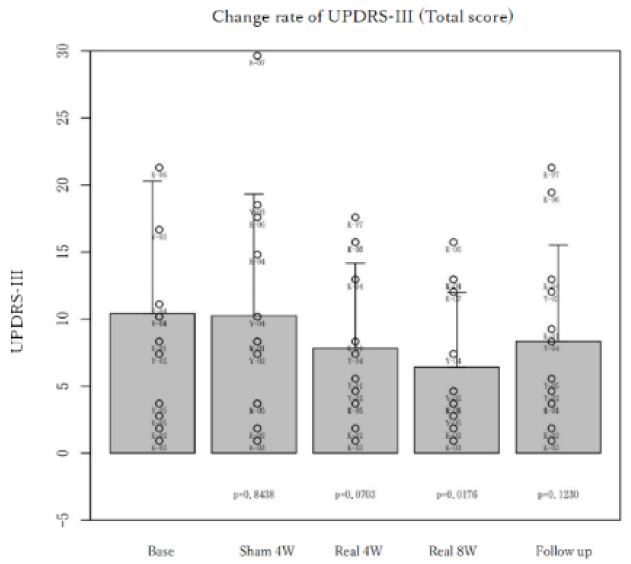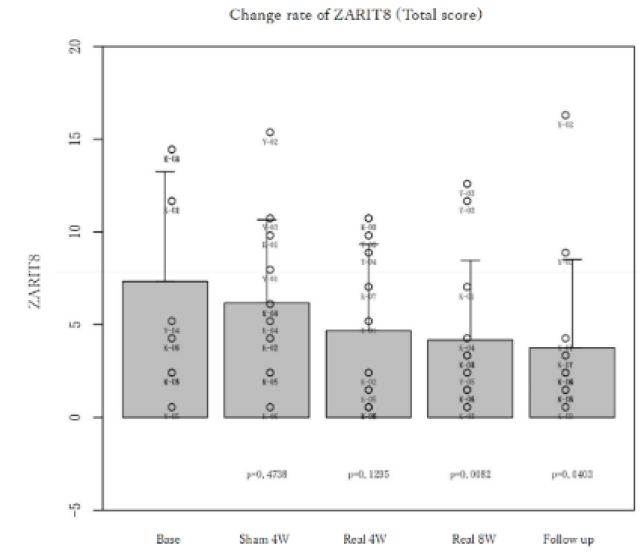Introduction
In 2004, we started research and development of a head ultrasonic stimulator and confirmed the safety in a non-clinical test. After that, we confirmed an increase in cerebral blood flow in humans, and proceeded to Phase 2 clinical trials. It will be planned to move to Phase 3 clinical trials. Kamiyama, Ltd. focused on the 30,000 Hz frequency band emitted by the dolphin and developed a head ultrasonic stimulator. It was developed based on the concept of vibrating capillaries and nerve cells with weak long-wave ultrasound.
The acoustic action frequency of medical equipment shall comply with JIS (Japanese Industrial Standards) T0601-2-5 (IEC 61689). “IEC 61689:1996, Ultrasonics-Physiotherapy requirements and methods of measurement in the frequency range 0.5 MHz to 5 MHz”. The ultrasonic frequency of the device is 30 KHz (0.03 MHz), which is non-standard ultrasonic. The wavelength in the body (simulated in water) is about 5 cm, and when stimulated from the forehead, it passes through the skull in 4-5 waves. The ultrasonic wave of 30 KHz have a low attenuation rate and is characterized by good penetration into the body. For capillaries and nerve cells of several micrometers, it is considered possible to vibrate with an energy of several microwatts/cm2. The ultrasonic intensity is approximately 1/100,000 or less of the intensity at which cavitation occurs.
It seems possible to transmit weak ultrasonic waves to capillaries and nerve cells in the brain without generating bubbles. It was confirmed that the device increases the cerebral blood flow with minute vibrations caused by approximately 7.2 million waves (pressure change) in 20 minutes of pulse stimulation.
The below are five papers on the efficacy and safety of non-clinical and clinical studies:
1) Sound Field Measurement in the Skull Model
The intensity of the sound generated in water by the 30 kHz ultrasonic transducer was 1/1,875 when compared with the maximum standard of JIS ultrasonic therapy equipment. In addition, the acoustic intensity in the skull model was 22 μW/cm2 or less, and the safety was confirmed.
2) Cerebral Blood Flow Promotion Effect
In clinical trial in healthy adults, the cerebral blood flow increased by approximately 10% to 15% after stimulation compared to before stimulation.
3) Clinical Trial for Patients with the Dementia with Lewy Body
In 12 patients, there was significant improvement in severity (NPI-Q) and Parkinsonian symptoms on the real device compared to the sham device.
4) Clinical Trial for Dementia Patients
Four patients with dementia with Lewy body and two patients with dementia of the Alzheimer’s type used the device for 12 weeks in combination with drugs. Improvements were shown on the NPI-Q and MMSE.
5) Report of one Case of Parkinson’s Disease Symptoms
The patient used the device in combination with medication. Improvements were observed in cognitive impairment and Parkinson’s symptoms, and the burden on caregivers was greatly reduced.
The Below are the Abstracts of Each Paper
1. The vibrator has a bimorph disk structure made of piezoelectric ceramics, and the vibrating energy is taken out from the center while the vibrator is held at the periphery [1]. The vibrating surface is made of ABS resin with a diameter of 28 mm (Figure 1), and is built into a hair band (Figure 2) and used in close contact with the head. Ultrasonic properties in medical devices are to be measured in water. The absorption of sound in water (in the body) is proportional to the square of the frequency, indicating that low frequencies propagate farther. The speed of sound propagating in the human body is approximately 1,500 m/s, which is equivalent to the propagation speed in water. The ultrasound frequency was set to 30 kHz, and the internal wavelength was 1,500 m/30 kHz=5 cm. The distribution of the sound intensity generated from the vibrating surface in water showed a conical shape (Figure 3), with a maximum of 1.6 mW/cm2 at the center of the vibrating surface. The transducer surface was a disk-shaped disk, and the average output from the emitting surface was 0.71 mW/cm2. Effective radiant power was obtained from the following formula. Effective radiant power=(radiating surface average power) x (radiating area)=(0.71 mW/cm2) x (n(1.4 cm)2)=4.4 mW. Acoustic distribution in the resin skull model was measured. The maximum output was simultaneously applied to the transducers attached to the outside of the frontal and occipital regions. Sound levels in the model were 3 μW/cm2 frontal, 22 μW/cm2 posterior foramen magnum, and 8 μW/cm2 occipital. The center area was mountain-shaped compared to the surrounding area, showing approximately five times the strength. When the acoustic vibration was applied to the skull, it was observed that it gathered in the brainstem.

Figure 1: Vibrator

Figure 2: Sound pressure distribution

Figure 3: Wearing
2. We investigated the changes in cerebral blood flow using a transcranial weak ultrasonic vibration stimulator with high-penetration long-wave ultrasound (30 kHz, 2 mW/cm2 or less) [2]. Stimulation of only the frontal region showed an increase of about 10% in blood flow throughout the brain in the X-ray CT image of Xe gas (Figure 4). Approximately 15% increase in cerebral blood flow (Figure 5) was observed in SPECT images with combined stimulation from the frontal and occipital regions (Figure 6).

Figure 4: Upper: Before, Lower: After

Figure 5: L: Before, C: after R: difference

Figure 6: Change rate of UPDRS-III (Total score)
3. A comparative clinical trial was conducted on 12 patients using the sham device and an actual device [3]. The primary endpoints were significant improvement in the severity of Behavioral and Psychological Symptoms of Dementia (NPI-Q) and caregiver burden (8 and 12 weeks later). As for the secondary endpoints, significant improvement was observed in the nursing care burden assessment Zarit-8 (Figure 7), and significant improvement was also observed in the cognitive function test “MMSE” (after 8 weeks). It also improved Parkinson’s symptoms associated with dementia with Lewy bodies. No adverse events were observed.

Figure 7: Change rate of ZARIT8 (Total score)
4. A total of 6 cases of dementia with Lewy bodies (DLB) and 2 cases of Alzheimer Type Dementia (ATD) were used for a total of 12 weeks in a 12-week clinical trial. Mini-Mental State Examination (MMSE) was used for cognitive function evaluation, and Neuropsychiatric Inventory Questionnaire (NPI-Q) was used for BPSD [4]. As a result, in 6 cases of MMSE and 5 cases of NPI-Q, improvements in cognitive function, psychiatric symptoms, patient severity, and caregiver burden were confirmed.
5. A 12-week clinical trial was conducted on a patient with Parkinson’s symptoms (Stage 4) in combination with drugs [5]. It was effective in treating cognitive impairment and Parkinson’s symptoms, had a high immediate effect, and was able to reduce the burden on caregivers. Wheelchair-bound patients with strong Parkinson’s symptoms can now walk with assistance.
References
- Okano S, Shimotori Y (2015) Measurement of sound field of ultrasound massager for the head in skull model: Iiryo kiki gaku 85: 14-21.
- Okano S, Shimotori Y, et al. (2015) Changes of Cerebral Blood Flow by the Weak Trans-Cranial Ultrasound Irradiation in Healthy Adult Volunteers: Japanese Journal of Complementally and Alternative Medicine 12: 73-78.
- Manabe Y, Shimotori Y (2023) A clinical study on the efficacy and safety of the head ultrasonic stimulator Ultra-Ma for patients with clinically diagnosed dementia with Lewy bodies: Clinical Study Report.
- FujiiI H, Shimotori Y, et al. (2021) Reduction of dementia symptoms by weak transcranial ultrasound therapy. Japan Society for Dementia Prevention 11: 49-57.
- FujiiI H, Shimotori Y (2022) Effects of Transcranial Weak Ultrasonic Stimulation on Parkinson’s Symptoms – Consideration Focused on Cognitive Function Tests Japanese Journal of Complementally and Alternative Medicine 19.